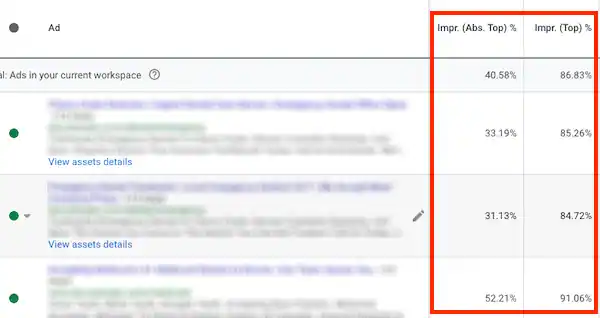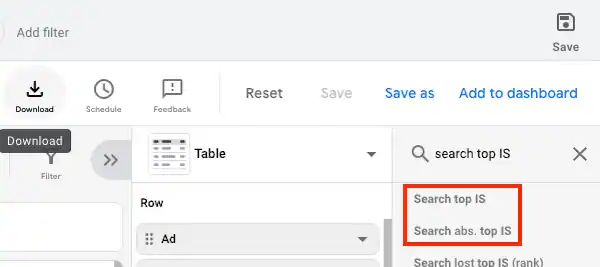What is Ad Rank?
Ad Rank is a metric used to decide the placement of your ad relative to other ads on a page and whether it will appear at all.
It is determined by a combination of factors, including your bid, the quality of your ad at the time of the auction (which takes into account expected clickthrough rate, ad relevance, and landing page experience), Ad Rank thresholds, auction competitiveness, and the context of the user’s search.
The latter includes the person’s location, device, time of search, nature of the search terms, and other user attributes.
Additionally, Ad Rank takes into consideration the potential impact of your assets and other ad formats, such as relevance, clickthrough rates, and prominence on the search results page.
Therefore, even if your competitors have higher bids, you can still win a higher position by using highly relevant keywords and ads.
Your Ad Rank is recalculated each time your ad is eligible to appear and participates in an auction, resulting in fluctuations in your ad position based on the competition, user context, and quality of your ad at that moment.
In Performance Max campaigns, the highest Ad Rank campaign or ad will be selected if the user’s search query is not identical to an eligible Search keyword, including the spell-corrected search term.
Tip
If you’re looking to gauge the placement of your ads on search engine result pages (SERPs) within the Search Network, you can refer to the “Impr. (Abs.Top) %” and “Impr. (Top) %” metrics to determine the absolute top and top impression rates, respectively.
Google Ads Report EditorIf you prefer to bid on page location, you can utilize the “Search abs. top IS” and “Search top IS” metrics (available only in the Reports editor) to track your absolute top and top impression share.

You can accomplish this through the use of the Target Impression Share bid strategy, which allows you to target the top or absolute top of the page.
How Ad Rank is calculated
Google’s ad auction system determines which ads to display and their positions on the search engine results page (SERP). Ad Rank is calculated for each ad participating in the auction, and determines their eligibility to appear in the SERP.
Typically, the ad with the highest Ad Rank secures the top position, and the second-highest ranking ad is placed in the second position, provided they meet the relevant thresholds and other criteria.
Ad Rank is comprised of six key factors at a high level:
- Bid: You can set your maximum bid for a click on your ad, which may not be the amount you actually pay. You can adjust your bid at any time.
- Ad and landing page quality: Google Ads evaluates the relevance and usefulness of your ad and the linked website to the user. Quality Score is used to summarize this evaluation, which can be monitored and improved in your Google Ads account.
- Ad Rank thresholds: To ensure that high-quality ads are displayed, minimum thresholds are set that must be met for an ad to appear.
- Auction competitiveness: If two ads have similar Ad Ranks, they have similar chances of winning the position. The higher-ranking ad is more likely to win, but it may cost more per click.
- User search context: Context plays a crucial role in Ad Rank calculation. Factors such as search terms, location, device type, time of search, other ads, and user attributes are all considered.
- Expected impact of ad assets and formats: Ad assets, such as a phone number or additional links to your site, can be added to your ad. Google Ads estimates the impact of these assets and other ad formats on ad performance.
Example
To illustrate how Ad Rank works, let’s consider an example where there are five advertisers with respective Ad Ranks of 80, 50, 30, 10, and 5. Suppose the minimum Ad Rank required to show above the search results is 40.
In this case, only the first two advertisers (with Ad Ranks of 80 and 50) will show above the search results since they exceed the minimum Ad Rank required.
Now, let’s assume that the minimum Ad Rank necessary to show below the search results is 8. In this case, two of the remaining three advertisers (with Ad Ranks of 30 and 10) will show below the search results, whereas the advertiser with an Ad Rank of 5 won’t show at all since it didn’t meet the minimum Ad Rank required.
In terms of top and absolute top metrics, the advertiser with an Ad Rank of 80 (in the first position above the results) will have one impression counting for both top and absolute top. The advertiser with an Ad Rank of 50 (in the second position above the search results) will have one impression on top.
However, the advertiser with an Ad Rank of 30 (in the first position below the search results) and the advertiser with an Ad Rank of 10 (in the second position below search results) won’t have any impressions on top or absolute top.
| Ad Rank | Absolute top impr. | Top impr. | Absolute top impr. % | Top impr. % | |
|---|---|---|---|---|---|
| Advertiser 1 | 80 | 1 | 1 | 100% | 100% |
| Advertiser 2 | 50 | 0 | 1 | 0% | 100% |
| Advertiser 3 | 30 | 0 | 0 | 0% | 0% |
| Advertiser 4 | 10 | 0 | 0 | 0% | 0% |
To increase your chances of appearing in the top and absolute top locations on the search result page, there are two main actions you can take:
- Improve the quality of your ads and landing page experience: Make sure your ads are relevant and engaging to the target audience, and that the landing page provides a positive user experience.
- Increase your bid: Consider raising your bid to increase your ad’s competitiveness and improve your ad rank, which can result in better ad placement. However, keep in mind that bidding higher doesn’t necessarily guarantee a top or absolute top location, as other factors also come into play.
Improving ad quality results in a higher Ad Rank
When an ad participates in an auction triggered by a search query, we calculate its Ad Rank based on your bid and various real-time factors such as expected CTR, ad relevance, and landing page experience. Improving the following factors can contribute to higher quality components of your Ad Rank:
- Historical clicks and impressions of your ad, considering other formats that may have impacted its visibility.
- The relevance of your ad to the search query.
- The quality of your landing page in terms of relevance, transparency, and ease of navigation.
- The expected performance of your ad based on its relevance and engagement history.
- The overall user experience of your website, including page load speed, mobile optimization, and user engagement.
The importance of having high-quality ads
The components that make up Ad Rank’s quality can impact several aspects of your ad’s performance, such as:
- Ad auction eligibility: Ad quality measures determine if your ad is eligible to appear at all and what Ad Rank thresholds it must meet.
- Actual cost-per-click (CPC): Ads with better quality often have lower CPCs, reducing the amount you pay per click.
- Eligibility for ad assets and other formats: Ad Rank determines if your ad is eligible to show with additional ad assets and formats, such as sitelinks. Overall, higher-quality ads can result in lower costs and more effective advertising. The Google Ads system works best when ads are relevant and closely match what customers are searching for.
Ad Rank: the mechanism that makes text ads cycle through the search result pages
The position of text ads on search result pages is determined by their Ad Rank, which is recalculated by Google Ads for each page.
The Ad Rank calculation considers whether your ad appeared on a previous page, which means your ad may appear in a top spot on one page and then appear in an “Other” spot on a subsequent page (or vice versa).